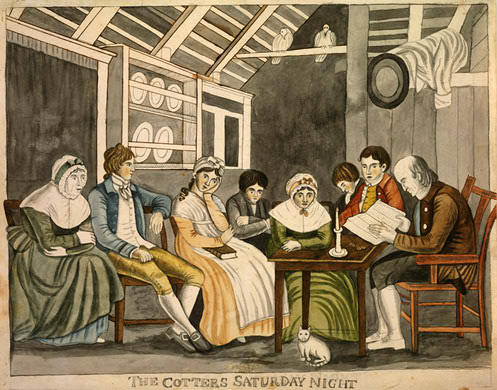
Back to Fall 07 English Calendar
Web Project 2 – American History through Art
 |
| Eunice
Pinney, The Cotters Saturday Night, c. 1815 pen and watercolor: 30.7 x 37.8 cm (12 1/8 x 14 5/8 in.) The National Gallery of Art |
For your second web project, you will be asked to present, examine, and interpret a work of American art. With a few exceptions, all of the works were produced before the Civil War.
As you have seen, the dominant narrative of our country finds itself repeated in history, literature, and art. As you look at these images, think about how they represent “America,” its heroes, its ordinary citizens, and those whose existence the narrative must somehow define or erase, African American slaves and Native Americans.
As always,
think about what kinds of questions you could ask of these images. What
is the “story” that these artists are telling American about
itself? How did we feel about our young democracy? How do some of these
images justify or simplify subjects that we now understand as deeply troubling
and complex? How does the sense of “mission” that began with
the Puritans replay itself in westward expansion? How did America want
to think about “the land” in the early 19th century? All of
the landscape painters on our list were very popular. Why do you think
that Thomas Cole’s sweeping allegories on The Course of Empire and
the Voyage of Life resonated with 19th century America? What aspects of
everyday life did the artists want to portray? How are women presented?
Did you notice that all of the artists on our list are male? How does
an artist like George Catlin resist the erasure or stereotyping of Native
Americans that you see in other artists? Do you think the artists are
reproducing the myth of America or creating it?
For your second project consider the following:
- Begin by finding an image of your work of art. You will need to include in your page the title of your painting/sculpture, the date of completion, the artist, the life dates of the artist, the medium (for example, oil on canvas), and the dimensions of the work.
- Content! Content! Content! In addition to your image, your page should contain 300 – 350 words of prose. The most attractive website is still ineffective if is doesn't provide clear, informative content.
Your page should include:
- Description – Most of you have never written about a work of art, but all of you can describe what you see. We'll be talking about this more in class.
- Historical Information – Your reader would appreciate some historical context about the subject matter of the work, the artist, or any important events that may have influenced the work. You must decide what your viewer would find most interesting.
- Interpretation – You can give your reader your own interpretation of the work. What do you think the artist wants the viewer to see? Does the artist have a particular point of view toward the subject matter? Is the artist making an argument? Do you think that you respond differently to the work as a 21st century American than the original audience would have responded? You are free here to make any interpretation or associations that you feel are important. There is not a formulaic answer here. We have so many different examples of art to consider.
- Acknowledgement of Sources – Again, carefully cite all of your sources for your image and historical content with in-text parenthetical citations. Conclude your page with a Works Cited section which lists your sources alphabetically.
Citing Electronic Sources in Your Web Pages
Checklist:
- Original Title
- Image of the work
- Essential information about the work – date, artist, medium, dimensions
- Description of work
- Historical context – background on artist, events, subject matter
- Interpretation
- 300 – 350 words of text
- Acknowledgement of sources for images and text in MLA format
- Links from your menu page to the project, and from your project back to the menu page
- Alt tag(s) for your image(s)
- Link
to an external website, opening in a new window, giving your viewer
more information
Optional:
- Additional image(s)
- Thumbnail of an image
Reproduction
of The Cotters Saturday Night:
Pinney, Eunice. (1770-1849). The Cotters Saturday Night. 1815. Online
image. 2004. The National Gallery of Art. Gift of Edgar William and Bernice
Chrysler Garbisch. 22 September 2004. <http://www.nga.gov/cgi-bin/pinfo?Object=52693+0+none>
